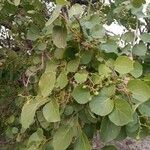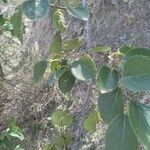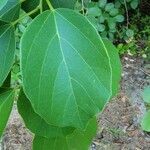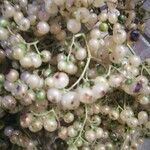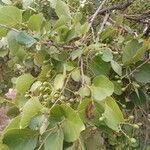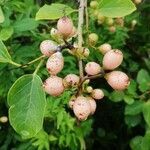Trees 3-4(-20) m tall. Petiole 2-5 cm; leaf blade ovate to broadly ovate or elliptic, 6-13 × 4-9 cm, sparsely pubescent or glabrous, base rounded to broadly cuneate, margin usually subundulate to undulate dentate, rarely entire, apex obtuse to mucronate. Inflorescences terminating leafy lateral branches, dichotomously branched into corymbose cymes, widely spaced, 5-8 cm wide. Flowers dimorphic, sessile. Calyx campanulate, 5-6 mm, 5-lobed; lobes unequal, triangular. Corolla white, ca. as long as calyx; lobes shorter than tube, margin somewhat undulate. Filaments of staminate flowers ca. 3.5 mm, filaments of bisexual flowers 1-2 mm. Rudimentary pistil globose. Style united portion 1-1.5 mm, first branches ca. 1 mm, second branches 2-3 mm; stigma spatulate. Drupes yellow or reddish, subglobose, 1-1.5 cm in diam., with sticky mesocarp, surrounded by persistent calyx. Fl. Feb-Apr, fr. Jun-Aug. 2n = 48, 50.
A medium sized tree, that loses its leaves at some times of the year. They are 5 to 15 m high. It can grow up to 27 m tall and be 50 cm across in the trunk. The tree has spreading branches. The bark is 2 cm thick and grey. It is deeply cracked. The leaves are alternate, smooth and pointed at both ends. They have 2-3, easy to see, veins. The veins are hairy on the underside. They are 5-8 cm long and 2-4 cm wide. The leaf stalk is 3-4 cm long. The flowers are white or yellow, and borne in flower clusters at the ends of branches. The flower clusters are 1-5 cm across, while individual flowers are 2 mm across. The flowers are orange, and funnel shaped at the base. Male and both sex flowers occur on separate trees. The fruit are yellowish white or pink, and soft but with a hard stone. They are 2 cm across and contain a sticky juice. The fruit is sweet and edible.
Pending. See references in Bibliography.
